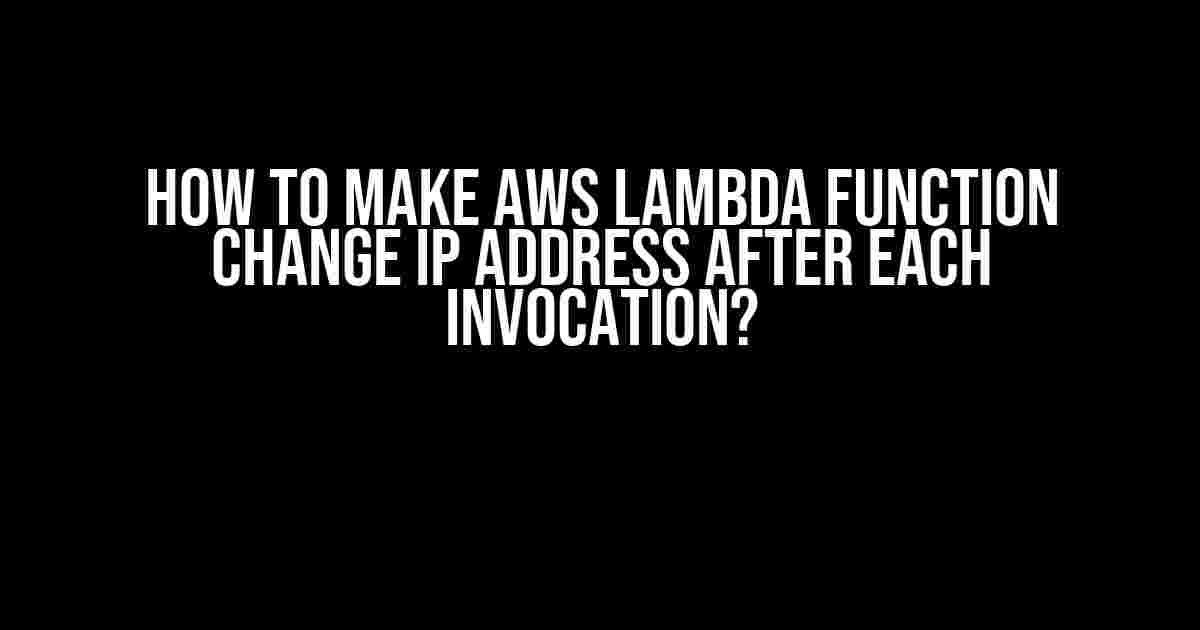Are you tired of using the same old IP address for your AWS Lambda function every time it’s invoked? Want to add an extra layer of security and flexibility to your serverless architecture? Look no further! In this article, we’ll show you how to make your AWS Lambda function change its IP address after each invocation, and why it’s a game-changer for your cloud-based applications.
Why Change IP Address After Each Invocation?
There are several reasons why you might want to change the IP address of your AWS Lambda function after each invocation:
- Security**: By rotating IP addresses, you can make it harder for attackers to target your function with IP-based attacks. This adds an extra layer of security to your application and protects against IP spoofing.
- Scalability**: If your function is invoked frequently, using a single IP address can lead to IP exhaustion. By changing the IP address after each invocation, you can ensure that your function can scale more efficiently.
- Flexibility**: Rotating IP addresses allows you to access external services that have IP-based restrictions. For example, you can rotate IP addresses to access APIs that have rate limits based on IP addresses.
Prerequisites
Before we dive into the tutorial, make sure you have the following prerequisites:
- An AWS account with the Lambda and VPC services enabled
- A basic understanding of AWS Lambda functions and VPC configurations
- The AWS CLI installed on your machine
Step 1: Create a VPC and Subnet
The first step is to create a VPC and subnet that will be used to allocate IP addresses to your Lambda function. Follow these steps:
aws ec2 create-vpc --cidr-block 10.0.0.0/16 --output text --query 'Vpc.VpcId'
aws ec2 create-subnet --vpc-id <VPC_ID> --cidr-block 10.0.1.0/24 --output text --query 'Subnet.SubnetId'
Replace `
Step 2: Create an IAM Role and Policy
Next, you need to create an IAM role and policy that will allow your Lambda function to access the VPC and subnet. Follow these steps:
aws iam create-role --role-name lambda-vpc-role --assume-role-policy-document file://trust-policy.json
aws iam create-policy --policy-name lambda-vpc-policy --policy-document file://policy.json
aws iam attach-role-policy --role-name lambda-vpc-role --policy-arn arn:aws:iam::123456789012:policy/lambda-vpc-policy
Create a file called `trust-policy.json` with the following contents:
{
"Version": "2012-10-17",
"Statement": [
{
"Effect": "Allow",
"Principal": {
"Service": "lambda.amazonaws.com"
},
"Action": "sts:AssumeRole"
}
]
}
Create a file called `policy.json` with the following contents:
{
"Version": "2012-10-17",
"Statement": [
{
"Effect": "Allow",
"Action": "ec2:DescribeNetworkInterfaces",
"Resource": "*"
},
{
"Effect": "Allow",
"Action": "ec2:CreateNetworkInterface",
"Resource": "*"
},
{
"Effect": "Allow",
"Action": "ec2:DeleteNetworkInterface",
"Resource": "*"
}
]
}
Step 3: Create a Lambda Function
Now, create a Lambda function that will use the IAM role and policy created in the previous step. Follow these steps:
aws lambda create-function --function-name lambda-vpc-function --runtime nodejs14.x --role arn:aws:iam::123456789012:role/lambda-vpc-role --handler index.handler --zip-file file:// lambda-function.zip
Create a file called `lambda-function.zip` that contains your Lambda function code. For this example, we’ll use a simple Node.js function that logs the IP address of the function:
exports.handler = async (event) => {
const https = require('https');
const os = require('os');
const interfaceOpts = {
SubnetId: '',
Description: 'Lambda VPC Interface'
};
const ec2 = new AWS.EC2({ region: 'us-west-2' });
const params = {
DryRun: false
};
try {
const data = await ec2.createNetworkInterface(interfaceOpts).promise();
const params = {
NetworkInterfaceId: data.NetworkInterface.NetworkInterfaceId
};
const allocation = await ec2.allocateAddress(params).promise();
const ip = allocation.PublicIpAddress;
console.log(`IP Address: ${ip}`);
return { statusCode: 200, body: `IP Address: ${ip}` };
} catch (err) {
console.error(err);
return { statusCode: 500, body: `Error: ${err}` };
}
};
Replace `
Step 4: Configure the Lambda Function to Change IP Address
Finally, configure the Lambda function to change its IP address after each invocation. You can do this by adding a environment variable to the function that specifies the `ENI` (Elastic Network Interface) to use:
aws lambda update-function-configuration --function-name lambda-vpc-function --environment-variables ENI=eni-12345678
Replace `eni-12345678` with the ID of the ENI created by the Lambda function in the previous step.
Testing the Lambda Function
To test the Lambda function, invoke it using the AWS CLI:
aws lambda invoke --function-name lambda-vpc-function --payload '{}' response.json
This will invoke the Lambda function and log the IP address of the function to the console. If you invoke the function multiple times, you should see a different IP address each time.
Conclusion
In this article, we’ve shown you how to make your AWS Lambda function change its IP address after each invocation using a VPC and subnet. This adds an extra layer of security and flexibility to your serverless architecture, allowing you to scale more efficiently and access external services that have IP-based restrictions.
Remember to update the IAM role and policy to include the necessary permissions for your Lambda function to access the VPC and subnet. Also, make sure to test your Lambda function thoroughly to ensure that it’s working as expected.
| Step | Description |
|---|---|
| 1 | Create a VPC and subnet |
| 2 | Create an IAM role and policy |
| 3 | Create a Lambda function |
| 4 | Configure the Lambda function to change IP address |
By following these steps, you can create a secure and scalable serverless architecture that takes advantage of the power of AWS Lambda.
Frequently Asked Question
Are you tired of using the same old IP address for your AWS Lambda function? Do you want to know the secret to making it change IP addresses with each invocation? Look no further! Here are the answers to your burning questions:
How does AWS Lambda decide which IP address to use for an invocation?
AWS Lambda uses a pool of IP addresses to make outbound calls. The IP address used for an invocation is chosen from this pool based on the AWS Region and the availability of IP addresses. However, you can’t directly control which IP address is used for a specific invocation.
Can I configure AWS Lambda to use a specific IP address for an invocation?
Unfortunately, no! AWS Lambda doesn’t support configuring a specific IP address for an invocation. However, you can use a NAT Gateway or an Elastic IP address with an Amazon EC2 instance to control the outbound IP address.
How can I make my AWS Lambda function change IP addresses after each invocation?
One way to achieve this is by using an EC2 instance with multiple Elastic IP addresses. You can create a script that assigns a new Elastic IP address to the instance before each Lambda invocation. This way, the Lambda function will use a different IP address for each invocation.
Is there a more straightforward way to rotate IP addresses for my AWS Lambda function?
Yes! You can use a service like API Gateway with a regional endpoint and enable IP address rotation. This way, API Gateway will rotate the IP address for each invocation of your Lambda function.
Are there any third-party services that can help me rotate IP addresses for my AWS Lambda function?
Yes, there are several third-party services, such as ProxyMesh or Ipify, that offer IP address rotation services. These services can provide a pool of IP addresses that can be used for outbound calls from your Lambda function.
Now you know the secrets to making your AWS Lambda function change IP addresses after each invocation! It’s time to get creative and take control of your IP addresses!


